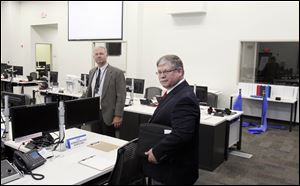
FirstEnergy opens emergency response center dedicated for Davis-Besse
10/24/2012
Fred Petersen, left, director of the Ottawa County Emergency Management Agency, and Ray Lieb, site vice president of Davis-Besse, tour the Davis-Besse Nuclear Power Station's new Emergency Operations Facility
LINDSEY, Ohio — First-Energy Nuclear Operating Corp. has spent $6 million on a 12,000-square-foot building it hopes to use as little as possible.
But if disaster strikes at the Davis-Besse nuclear power plant — be it catastrophic weather, a terrorist attack, or a radiological accident within the plant itself — utility officials say the nondescript, windowless Emergency Operations Facility will enable them to keep up with the situation and coordinate response with area officials.
“In case there’s an emergency that makes the [plant] site inaccessible, we have someplace we can go,” Jennifer Young, a FirstEnergy spokesman, said after a ribbon-cutting ceremony Tuesday morning. The facility will officially replace a smaller response center at the plant at noon Friday.
“It’s safer to have a meeting location and response facility that is 15.4 miles away,” said Jim Vetter, the quality assurance manager at Davis-Besse. It’s also required by the Nuclear Regulatory Commission, he noted, that such a facility be located between 10 and 25 miles from every nuclear power plant.
The facility next door to Toledo Edison’s Lindsey Service Center on State Rt. 590 just south of the Sandusky County village “plays a critical role in protecting the health and safety of the public by supporting timely, efficient communications with emergency responders in the event of an urgent situation at the plant,” said Ray Lieb, FirstEnergy’s site vice president for Davis-Besse.
The Emergency Operations Facility’s centerpiece is a large room with dozens of computers and telephones on banks of desks, with many seats reserved for specific staff of First Energy Nuclear Operating Corp. and regulatory and public agencies. Large projection displays around the walls show the status of various Davis-Besse functions, as well as event logs for any particular response.
A small side room is set aside for experts in “dose assessment” — evaluating the path and strength of any radiation release that might occur — and a separate conference room, dividable in two, is reserved for Nuclear Regulatory Commission officials.
Computers, displays, radios, and telephones are “all advanced from what’s at the plant,” Mr. Vetter said. “We really invested in a lot more computer capability than we have at the plant.”
A second large room houses a Technical Support Center, which features many of the same displays and equipment but is intended for use by FirstEnergy engineering staff to monitor and evaluate plant incidents. It duplicates an existing tech center at the plant.
“We can send our engineers out here, and have all the same resources available to them,” Ms. Young said.
What the facility cannot do is control plant operations remotely, but it has direct communication with Davis-Besse that includes links to its operating systems data. Along with its main control facilities, the plant has an auxiliary room from which its nuclear reactor can be shut down, Mr. Vitter said.
The Emergency Operations Facility has redundant telephone and data lines and a diesel generator to provide backup electricity in the event the power is out locally.
Mr. Lieb said the center will be used for meetings, training exercises, and drills — with the first drill scheduled for Nov. 1 — but won’t be staffed on a regular basis.
FirstEnergy built Emergency Operations Facilities near its Perry and Beaver Valley nuclear plants — in northeast Ohio and southwest Pennsylvania, respectively — that are identical, right down to the walls’ colors, to the one for Davis-Besse.
“If we needed to pull people in from our other facilities, they will be familiar with the layout and equipment,” Ms. Young said.
“I think it’s wonderful. It’s going to be a marked difference for them,” said Fred Petersen, the director of the Ottawa County Emergency Management Agency who was one of the local officials who toured the facility after the ribbon-cutting.
“The advanced technology is definitely required. It gives them another tool in the toolbox” for responding to emergencies, Mr. Petersen said, adding, “I’d like to have a new EOF like this.”
Contact David Patch at: dpatch@theblade.com or 419-724-6094.